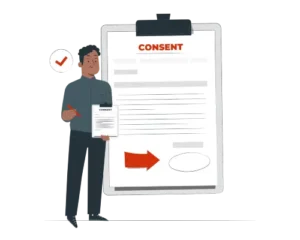Editor’s Note: This blog was originally published in July 2023 and has been updated for freshness, accuracy, and comprehensiveness.
5 Major Challenges to Consider Before Implementing RPA
- Selecting Right Process
- Complexity of Existing Processes
- Data Quality and Integration
- Change Management and Employee Resistance
- Security and Compliance
1. Selecting Right Process
Selecting the right processes for automation is a critical initial step in a successful Robotic Process Automation (RPA) implementation. Not all processes are suitable candidates for automation, and choosing the wrong ones can lead to wasted resources, inefficiencies, and RPA failure. In this context, careful consideration, analysis, and strategic planning are essential to identify processes that align with business goals and are conducive to automation.
Challenges
Complexity and Variability:
While Robotic Process Automation (RPA) has been growing in popularity, it is important to understand its limitations. RPA works best in rule-based, repetitive tasks, where the processes are stable and predictable.
However, in cases where the processes are complex and variable, and involve a high degree of decision-making and human judgment, RPA may not be the most effective solution. Such processes require a high level of cognitive ability and contextual understanding that machines may not possess.
Therefore, it is crucial to evaluate the suitability of RPA before implementing it, and consider alternative solutions such as Intelligent Automation, which combines RPA with Artificial Intelligence (AI) and Machine Learning (ML) to handle complex and variable processes.
Insufficient Volume of Transactions:
When considering the implementation of Robotic Process Automation (RPA), it is important to note that processes with low transaction volumes may not necessarily yield significant returns on investment. The automation of such processes may not always justify the costs associated with implementing RPA.
In such cases, it may be more beneficial to focus on other areas that can provide a greater return on investment. It is crucial to evaluate the potential benefits of RPA against the costs and resources required for implementation before making a decision.
Solutions
Strategic Analysis and Assessment:
Conduct a thorough business process analysis to identify tasks suitable for automation. Use criteria such as rule-based nature, transaction volume, and stability. Leverage process mining tools to gain insights into existing processes and identify automation opportunities.
Consultation with Stakeholders:
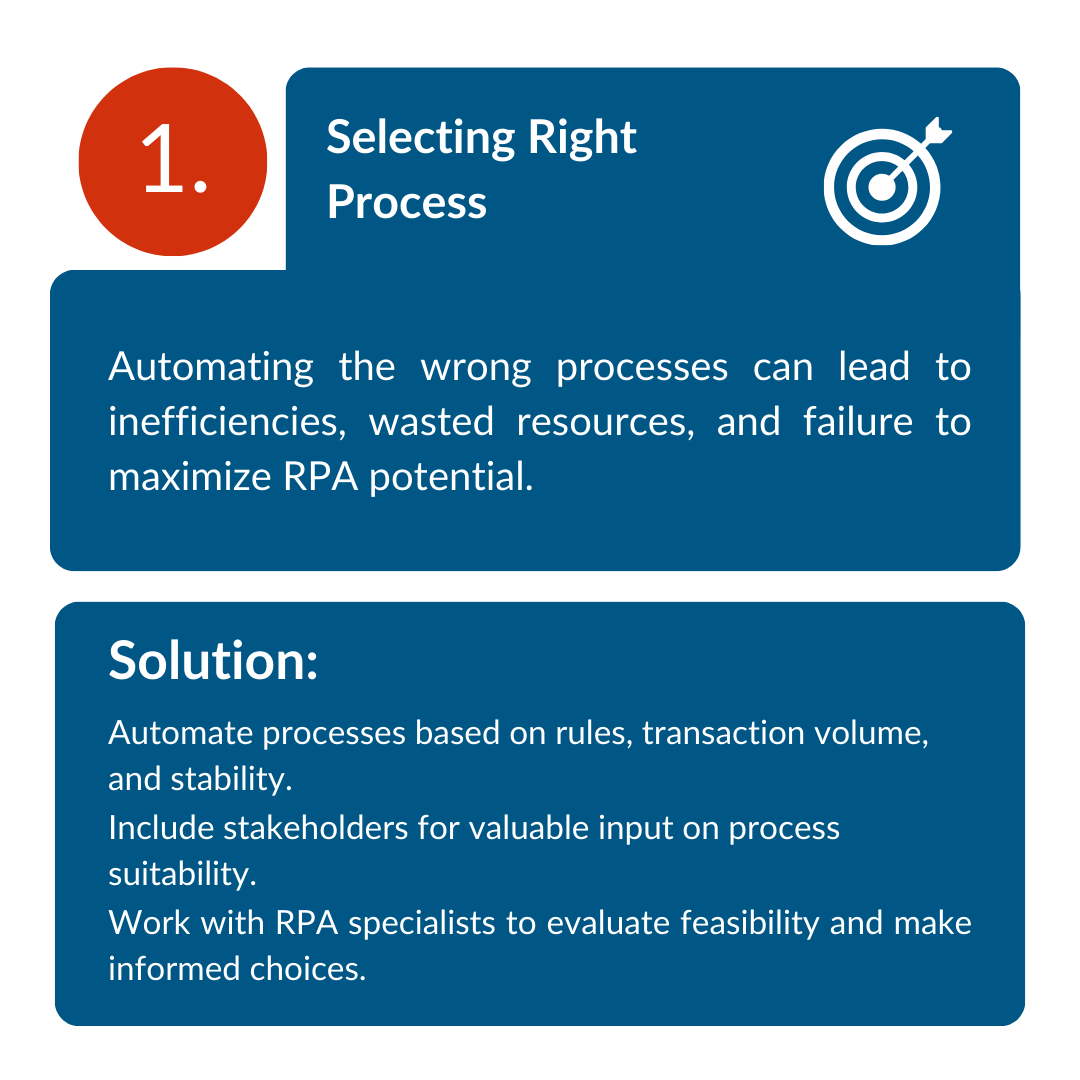
Involve key stakeholders, including process owners and end-users, in the selection process. Their insights can provide valuable perspectives on the suitability of processes for automation and potential challenges.
Partnership with RPA Experts:
Collaborate with established RPA service providers or consultants. These experts can offer insights into best practices, assess the feasibility of automating specific processes, and guide the organization in making informed decisions.
2. Complexity of Existing Processes
One of the first challenges businesses face when implementing RPA is the complexity of their existing processes. Many organizations have convoluted and intricate workflows that have evolved over time. Automating these processes often requires a deep understanding of the intricacies, which can be a significant hurdle. Before implementing RPA, it’s crucial to thoroughly document and analyze the current processes to ensure a seamless transition to automation.
Challenges
Automating complex, intricate, and unstandardized processes with Robotic Process Automation (RPA) can pose several challenges, including:
Unforeseen Exceptions:
Complex processes often involve subtle nuances, exceptions, and edge cases that can be difficult to capture and codify in an RPA bot. This is because these processes may require human judgment and decision-making, which can be hard to replicate in an automated system. As a result, it is important to carefully evaluate and consider the intricacies of a process before implementing RPA.
Workflow Replication Issues:
Automating complex processes using RPA bots can be challenging as involves multiple steps, decision-making points, and interactions with various systems. These factors make it difficult to replicate the workflow accurately, which can hinder the effectiveness of the automation process.
Difficulty in Interpreting Structure:
When business processes lack standardization, it can lead to inconsistent structure and documentation. This, in turn, creates a challenge for RPA bots to identify and interpret the necessary data and actions. As a result, automating such processes can be difficult and time-consuming. Therefore, it is important to ensure that processes are standardized and well-documented for implementing RPA.
Solutions
Conducting a Comprehensive Process Audit
The first step towards automating complex processes lies in conducting a meticulous process audit. This involves systematically examining the existing workflow, and identifying bottlenecks, inefficiencies, and areas for improvement. The audit should delve into the intricacies of the process, uncovering redundant steps, complex decision-making points, and inconsistencies in data handling.
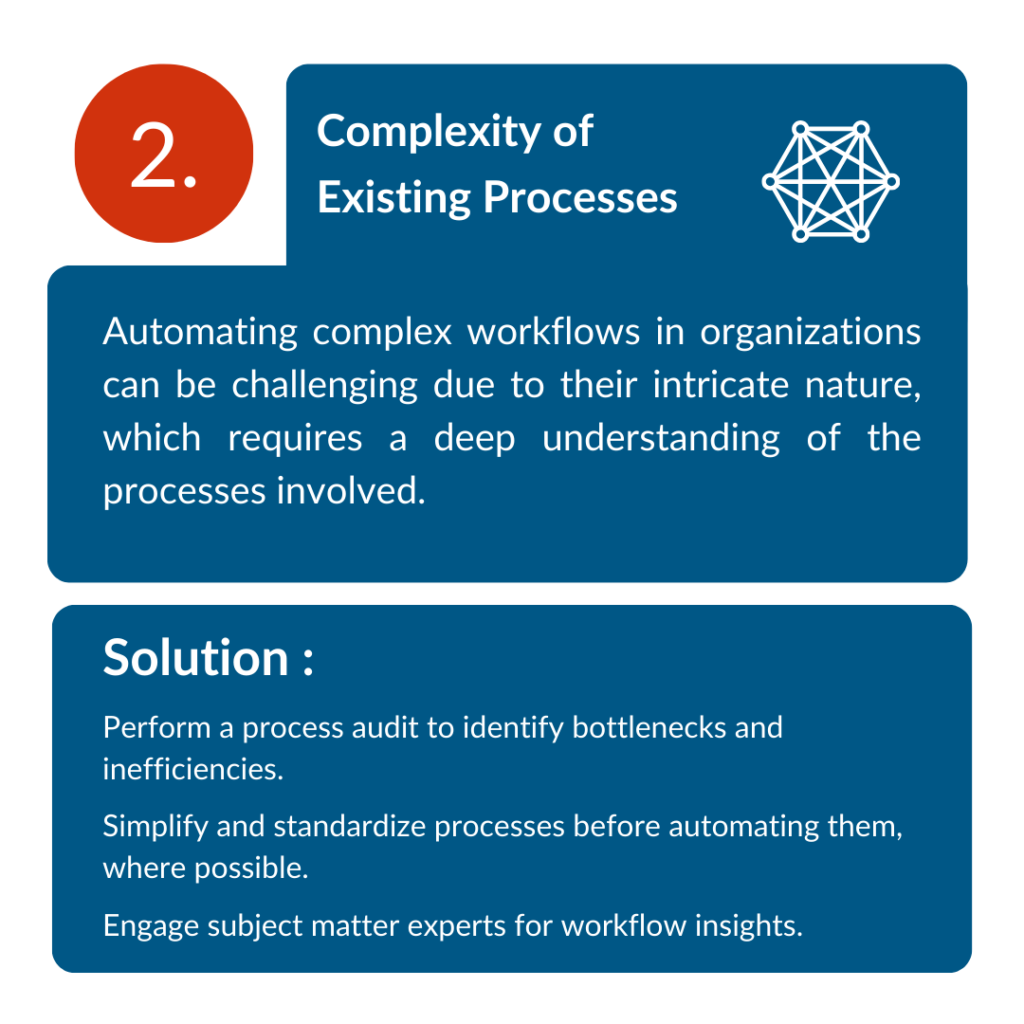
Simplifying and Standardizing Processes
Once the audit has revealed the challenges, the next step is to simplify and standardize the processes wherever possible. This involves eliminating unnecessary steps, streamlining decision-making criteria, and enforcing consistent data formats. By simplifying the processes, organizations lay the foundation for effective RPA implementation.
Leveraging Subject Matter Expertise
Involving subject matter experts (SMEs) is crucial for capturing the nuances and complexities of the workflow. SMEs possess deep knowledge of the process, its underlying rationale, and the potential challenges that may arise during automation. Their insights are invaluable in ensuring that the RPA implementation accurately reflects the intricacies of the process.
3. Data Quality and Integration
Successfully implementing Robotic Process Automation (RPA) hinges on the seamless integration of accurate and up-to-date data. RPA systems heavily rely on data to execute tasks efficiently, automating repetitive processes within an organization. However, inconsistent data formats and outdated databases present formidable obstacles in this journey. The very foundation of RPA is shaken when confronted with data that lacks uniformity or resides in legacy systems that may not align with contemporary standards. The need to integrate RPA with multiple systems further exacerbates the challenge, as it demands a harmonious flow of information across diverse platforms.
Challenges
Implementing RPA using inconsistent data formats and outdated databases has the following challenges:
Data Parsing and Interpretation Issues:
RPA bots rely on structured data to perform their tasks. Inconsistent data formats can make it difficult for bots to parse and interpret the data accurately, leading to errors and inefficiencies.
Reduced Scalability:
Inconsistent data formats can hinder the scalability of RPA solutions. As the volume of data grows, it becomes increasingly challenging to manage and automate processes that involve data with varying formats.
Compatibility Issues:
RPA bots need to seamlessly connect with existing databases to retrieve and manipulate data. Outdated databases may have incompatible interfaces or protocols, requiring additional development effort and potentially hindering integration.
Performance Bottlenecks:
Outdated databases may not be optimized for handling the demands of RPA automation. This can lead to performance bottlenecks, slowing down processes and reducing overall efficiency.
Solutions
To effectively address the hurdles posed by inconsistent data formats and outdated databases during the implementation of Robotic Process Automation (RPA), organizations should embrace a comprehensive strategy. This strategy should involve thorough data cleansing, robust data integration, and the implementation of sound data governance practices. Below is the detailed breakdown:

Data Cleansing and Normalization:
Data cleansing and normalization are essential steps in preparing data for RPA implementation. Data cleansing involves identifying and correcting errors, removing duplicate entries, and standardizing data formats. This process ensures that the data upon which RPA bots rely is accurate, consistent, and reliable.
Data normalization, on the other hand, focuses on structuring data in a consistent and organized manner, eliminating redundancies and improving data integrity. By investing in data cleansing and normalization processes, organizations can minimize the risk of errors arising from poor data quality, leading to more efficient and accurate RPA automation.
Robust Data Integration:
RPA bots often require access to data from various sources, such as legacy systems, databases, and cloud applications. Outdated databases and data silos can hinder the flow of information, making it difficult for RPA bots to access the data they need.
To overcome this challenge, organizations should implement robust data integration tools. These tools facilitate the exchange of data between different systems, ensuring that RPA bots have access to up-to-date and relevant information.
By adopting data integration tools, organizations can break down data silos, enabling RPA bots to seamlessly access data from multiple sources, leading to improved automation performance and informed decision-making.
Data Governance Practices:
Maintaining data quality and integrity throughout the RPA lifecycle is crucial for the success of RPA implementation. To achieve this, organizations should establish data governance practices. Data governance involves implementing policies and procedures for data collection, management, and access. It also involves defining clear data ownership and access rights to prevent unauthorized data modifications.
By establishing data governance practices, organizations can ensure that data remains accurate, consistent, and usable for RPA bots, leading to informed decision-making, enhanced data security, and sustainable RPA effectiveness.
4. Change Management and Employee Resistance
Introducing RPA into your organization will inevitably disrupt the status quo. Employees may feel threatened by the idea of automation, fearing job losses or a change in their roles. Change management is vital to address these concerns and ensure a smooth transition.
Challenges
Beyond the technical and organizational hurdles, employee resistance poses a significant challenge that can hinder the successful integration of RPA. While employee resistance may not directly impede the implementation process, its indirect effects can be detrimental to the overall success of RPA initiatives. Here’s how:
Lack of Understanding and Awareness:
When implementing RPA, organizations often face a lack of understanding and awareness among employees. Many employees may not know what RPA is or how it will affect their work. This lack of knowledge can lead to fear, uncertainty, and resistance to change.
Organizations need to take steps to address this by providing employees with clear and concise information about RPA, its benefits, and how it will impact their jobs.
Lack of Training and Support:
Lack of training and support can also be a major barrier to successful RPA implementation. Employees need training on how to use RPA tools and how to integrate them into their workflows. They also need support from IT and other teams to troubleshoot issues and get the most out of the technology.
Organizations should provide comprehensive training programs and ongoing support to ensure that employees are able to adopt and use RPA effectively. Without proper training and support, RPA can fail to deliver on its promises and may even disrupt employee morale and productivity.
Solutions
To effectively address employee resistance and foster a culture of acceptance towards RPA adoption, organizations should prioritize open and transparent communication strategies. Clearly articulating the benefits of RPA, both to the organization and to the employees themselves, is crucial to dispel any misconceptions and alleviate concerns. Engaging employees in the implementation process, seeking their input and feedback, and fostering a sense of ownership can significantly reduce resistance and promote a collaborative approach.
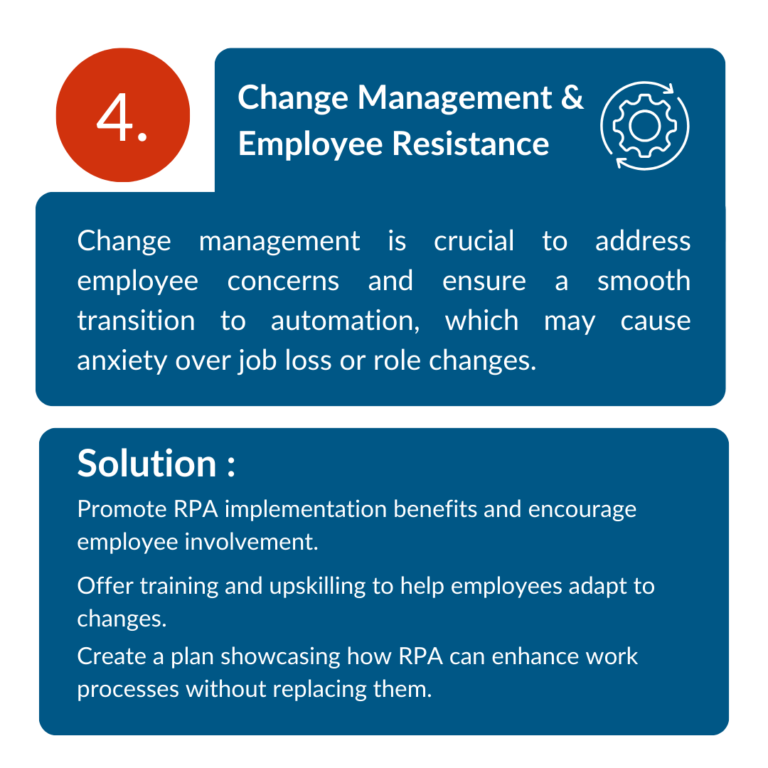
Investing in Employee Development:
Investing in employee training and upskilling opportunities is essential to ensure a smooth transition to an RPA-driven work environment. Providing comprehensive training sessions tailored to specific roles and responsibilities will equip employees with the necessary skills to utilize RPA effectively. Additionally, offering opportunities for continuous learning and upskilling will empower employees to adapt to the evolving technological landscape and enhance their career prospects.
Addressing Job Displacement Concerns:
Addressing job displacement concerns with transparency and honesty is paramount to mitigating employee resistance. Organizations should openly discuss the potential impact of RPA on job roles and responsibilities, providing clear and accurate information. Emphasizing the opportunities for reskilling and upskilling will demonstrate a commitment to employee development and alleviate fears of redundancy.
Showcasing RPA as an Enhancer:
Reframing the narrative surrounding RPA as an enhancer, rather than a replacement, is critical to gaining employee buy-in. Organizations should clearly articulate how RPA will augment existing skills, automate repetitive tasks, and free up employees to focus on more value-added activities. Highlighting the positive impact of RPA on employee satisfaction, productivity, and career growth will foster a sense of empowerment and acceptance.
5. Security and Compliance
Automating critical processes means dealing with sensitive data. Maintaining data security and regulatory compliance is non-negotiable. Neglecting this aspect can result in severe consequences for your organization.
Challenges
Credential Management:
RPA bots often require access to sensitive data and systems, making it crucial to implement robust credential management practices. This includes strong password policies, multi-factor authentication, and privileged access management solutions.
Unauthorized Access:
RPA bots act as automated users within an organization’s IT infrastructure, increasing the risk of unauthorized access. To mitigate this risk, organizations should establish clear access control policies, limit bot access to only necessary resources, and regularly monitor bot activities.
Solutions
Access Controls:
To ensure a secure and compliant RPA implementation, establishing robust access controls and identifying relevant regulations are paramount. Access controls limit who can interact with and access sensitive information and systems within the RPA environment. This includes implementing multi-factor authentication, role-based access controls, and network segmentation to restrict unauthorized access and minimize potential security risks.
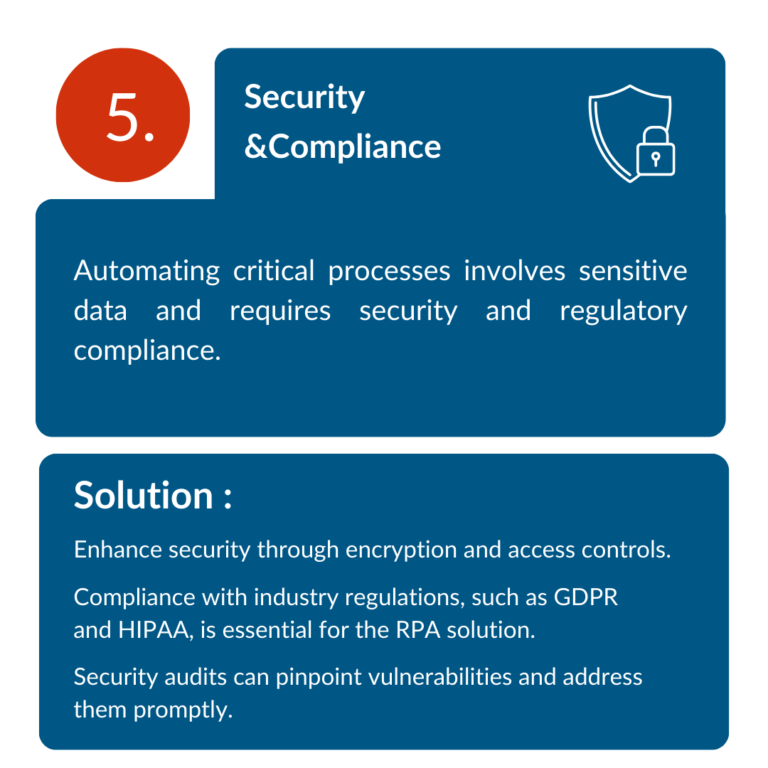
Identify Applicable Regulations:
Identifying applicable regulations, such as GDPR, HIPAA, and PCI DSS, is equally important. Understanding these regulations necessitates careful assessment of the data handled by RPA bots and the overall business operations. This step ensures compliance with data privacy, security, and reporting requirements, mitigating potential legal ramifications and protecting sensitive information.
Conclusion
In conclusion, while RPA offers immense potential for enhancing operational efficiency and reducing costs, it’s essential to be aware of the challenges involved in its implementation. RPATech, as a leading RPA service and solution provider, is well-equipped to help your organization navigate these challenges successfully. By choosing RPATech as your RPA partner, you can leverage their expertise and experience to maximize the benefits of automation while mitigating potential risks.




